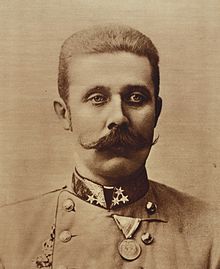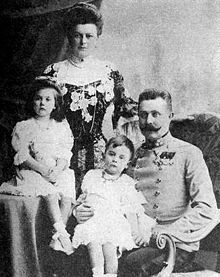Archduke Franz Ferdinand of Austria: Difference between revisions
| Line 46: | Line 46: | ||
== Assassination== |
== Assassination== |
||
:'' See main article [[Assassination of Franz Ferdinand]].'' |
:'' See main article [[Assassination of Franz Ferdinand]].'' |
||
On [[June 28]], [[1914]], at approximately 11:00 am, Ferdinand and his wife were killed in [[Sarajevo]] by [[Gavrilo Princip]], a member of [[Young Bosnia]] (or perhaps [[The Black Hand]]). The event, known as the ''Assassination in Sarajevo'', was the trigger of [[World War I]]. Franz Ferdinand is interred in [[Schloß Artstetten]], [[Austria]]. Gavrilo Principi was the last of nine individuals sent to Sarajevo for the purpose of assassinating the Archduke. |
On [[June 28]], [[1914]], at approximately 11:00 am, Ferdinand and his wife were killed in [[Sarajevo]] by [[Gavrilo Princip]], a member of [[Young Bosnia]] (or perhaps [[The Black Hand]]). The event, known as the ''Assassination in Sarajevo'', was the trigger of [[World War I]]. Franz Ferdinand is interred in [[Schloß Artstetten]], [[Austria]]. Gavrilo Principi was the last of nine individuals sent to Sarajevo for the purpose of assassinating the Archduke. Archduke Ferdinand's death is attributed largely to his hemophilia, rather than any particular marksmanship on Gavrilo Principi's part. |
||
==See also== |
==See also== |
||
Revision as of 19:05, 4 May 2006

His Imperial and Royal Highness Archduke Franz Ferdinand of Austria-Este (Franz Ferdinand Karl Ludwig Josef von Habsburg-Lothringen) (December 18, 1863 – June 28, 1914) was an Archduke of Austria and from 1896 until his death heir presumptive to the Austro-Hungarian throne. His assassination in Sarajevo, Austrian-annexed Bosnia-Herzegovina, precipitated the Austrian declaration of war against Serbia which triggered World War I.
See the article Assassination of Franz Ferdinand for a detailed discussion of these events.
Birth and early life

Franz Ferdinand was born in Graz, Austria, the eldest son of Archduke Karl Ludwig of Austria (younger brother of Emperor Franz Josef) and of his second wife, Princess Maria Annunciata of the Two Sicilies. When he was only 12 years old, his cousin Duke Francis V of Modena died, naming Franz Ferdinand his heir on condition that he add the name Este to his own. Franz Ferdinand thus became one of the wealthiest men in Europe.
When he was born, there was no reason to think that Franz Ferdinand would ever be heir to the Austro-Hungarian throne. He was given the normal strict education of an archduke with an emphasis on history and moral character. From 1876 to 1885 his tutor was the historian Onno Klopp. In 1877 Franz Ferdinand entered the army with the rank of second lieutenant.
As a young man Franz Ferdinand developed two great passions: hunting and travel. It is estimated that he shot more than 5,000 deer in his lifetime. In 1883 he visited Italy for the first time in order to see the properties left to him by Duke Francis V of Modena. In 1885 he visited Egypt, Palestine, Syria, and Turkey. In 1889 he visited Germany.
In 1889 Franz Ferdinand's life changed dramatically. His cousin Crown Prince Rudolf died, leaving Franz Ferdinand's father, Archduke Karl Ludwig, as first in line to the throne. Henceforth, Franz Ferdinand was groomed to succeed.
Marriage and family
In 1895 Franz Ferdinand met Countess Sophie Chotek at a ball in Prague. To be an eligible marriage partner for a member of the House of Habsburg, one must be a member of one of the reigning or formerly reigning dynasties of Europe. The Choteks were not one of these families, although they did include among their ancestors in the female line princes of Baden, Hohenzollern-Hechingen, and Liechtenstein.
Sophie was a lady-in-waiting to Archduchess Isabella, wife of Archduke Friedrich, Duke of Teschen. Franz Ferdinand began to visit Archduke Friedrich's villa in Bratislava (formerly Pressburg). Sophie wrote to Franz Ferdinand during his convalescence from tuberculosis when he went to the island of Lošinj in the Adriatic. They kept their relationship a secret for more than two years.
Archduchess Isabella assumed that Franz Ferdinand was enamored with one of her daughters. In 1898, however, he left his watch lying on a tennis court at her home. She opened the watch, expecting to find there a photograph of one of her daughters; instead, she found a photograph of Sophie. Sophie was immediately dismissed from her position.
Franz Ferdinand refused to consider marrying anyone else. Pope Leo XIII, Tsar Nicholas II of Russia, and the German Emperor Wilhelm II all made representations on Franz Ferdinand's behalf to the Emperor Franz Joseph of Austria, arguing that the disagreement between Franz Joseph and Franz Ferdinand was undermining the stability of the monarchy.
Finally, in 1899, the Emperor Franz Joseph agreed to permit Franz Ferdinand to marry Sophie, on condition that the marriage would be morganatic and that their descendants would not have succession rights to the throne. Sophie would not share her husband's rank, title, precedence, or privileges; as such, she would not normally appear in public beside him.
The wedding took place on July 1, 1900, at Reichstadt (now Zákupy) in Bohemia; Franz Joseph did not attend the affair, nor did any archduke including Franz Ferdinand's brothers. The only members of the imperial family who were present were Franz Ferdinand's stepmother, Maria Theresia, and her two daughters. Upon the marriage, Sophie was given the title Princess of Hohenberg (Fürstin von Hohenberg) with the style Her Serene Highness (Ihre Durchlaucht). In 1909 she was given the more senior title Duchess of Hohenberg (Herzogin von Hohenberg) with the style Her Highness (Ihre Hoheit). This raised her status considerably, but she still took precedence at court after all the archduchesses. Whenever a function required the couple to gather with the other members of royalty, Sophie was forced to stand far down the line of importance, separated from her husband.
Franz Ferdinand's children were:
- Princess Sophie von Hohenberg (1901-1990), married Count Friedrich von Nostitz-Rieneck (1891-1973)
- Maximilian, Duke of Hohenberg (1902-1962), married Countess Elisabeth von Waldburg zu Wolfegg und Waldsee (1904-1993)
- Prince Ernst von Hohenberg (1904-1954), married Marie-Therese Wood (1910-1985)
- stillborn son (1908)
Politics
Franz Ferdinand alienated many sections of Austro-Hungarian political opinion: Hungarian nationalists opposed his advocacy of universal male suffrage which would undermine Magyar domination in the Hungarian kingdom; both supporters and opponents of the Empire's existing dualist structure were suspicious of his idea for a third Croat-dominated Slav kingdom including Bosnia and Herzegovina as a bulwark against what was perceived in Vienna's Ballhausplatz (Foreign Ministry) as Serbian irredentism; and non-Catholics and anticlericalists were angered by his patronage (April 22, 1900) of the Catholic Schools Association.
Although Franz Ferdinand was seen outside Germany as a leader of the "war party" within Austria-Hungary, this was entirely untrue. In fact, the Archduke was one of the leading advocates of maintaining the peace within the Austro-Hungarian government during both the Bosnian Crisis of 1908-1909 and the Balkan Wars Crises of 1912-1913.
No evidence has been found to support suggestions that his low-security visit to Sarajevo was arranged by elements within Austro-Hungarian official circles with the intention of exposing him to the risk of assassination so as to remove a potentially troublesome royal personage from the scene.
Assassination
- See main article Assassination of Franz Ferdinand.
On June 28, 1914, at approximately 11:00 am, Ferdinand and his wife were killed in Sarajevo by Gavrilo Princip, a member of Young Bosnia (or perhaps The Black Hand). The event, known as the Assassination in Sarajevo, was the trigger of World War I. Franz Ferdinand is interred in Schloß Artstetten, Austria. Gavrilo Principi was the last of nine individuals sent to Sarajevo for the purpose of assassinating the Archduke. Archduke Ferdinand's death is attributed largely to his hemophilia, rather than any particular marksmanship on Gavrilo Principi's part.
